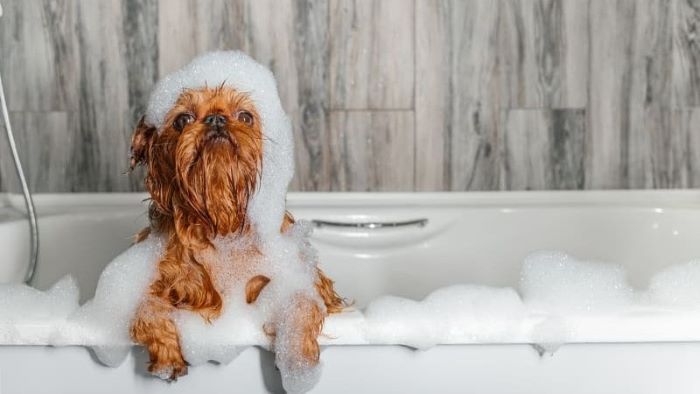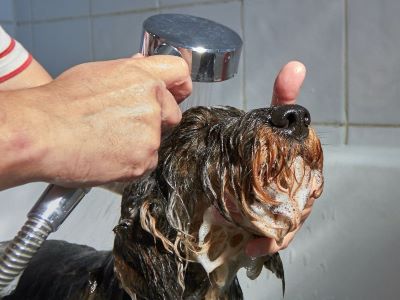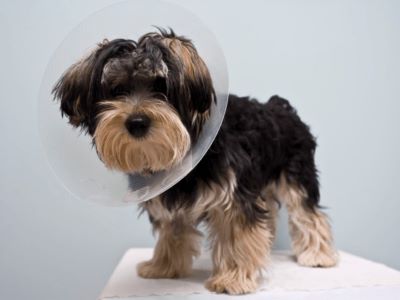How long after being neutered can a dog have a bath? Neutering, the surgery to remove a male dog’s testicles, is typically done around six months of age.⌛

It has various benefits, from population control to behavioural improvement and health benefits, but it’s crucial to know when it’s safe to give your dog a bath after neutering.
Bathing too soon can harm the surgical site. This article discusses when it’s okay to bathe your neutered dog, considering factors like breed and healing progress.
How Long After Being Neutered Can a Dog Have a Bath?
After a dog is neutered, it is best to wait 10-14 days before giving them a bath. Neutering is surgery to remove a male dog’s testicles, usually done around 6 months old. Neutering prevents unwanted litter, eliminates cancer risk, and reduces prostate disease risk.🏥
“It also decreases roaming, fighting, biting, mounting and marking behaviours. It can curb aggression towards other dogs and people. Overall, neutering improves health and behaviour in male dogs”, say the experts at AKC.🐶
The surgery requires an incision that needs time to start healing before it gets wet. Bathing too soon can disrupt the healing. Waiting 10-14 days gives the incision time to begin closing up and get stronger.

It also allows any swelling or inflammation from the surgery to go down and reduces the risk of infection. Some vets say bathing after 7 days is okay, but waiting the full 10-14 days is ideal.
"Don’t bathe the dog for at least 10 days post-surgery⌛, also don’t let the dog run and jump on and off things for up to 2 weeks after surgery", says the experts at PetMD.
Factors Affecting the Timing
The size of your dog plays a significant role, as smaller dogs often tend to heal faster than larger ones. smaller incisions on tiny breeds usually require less time to close compared to those on larger breeds.
Certain dog breeds have thicker or double coats that can trap moisture close to the skin, creating a potentially ideal environment for bacterial growth if not thoroughly dried. Breeds with dense fur, like Huskies or Pomeranians, may require extra care to ensure complete drying post-bath.🛁
Waiting a bit longer before bathing them allows the incision area to be less vulnerable. Each dog’s healing process is unique. It’s crucial to consult your vet during the healing period.
In addition to the special considerations for bathing after neutering surgery, it's important to follow general bathing guidelines for dogs. This includes knowing how often should you bathe a dog for optimal health and hygiene.
Bathing Tips When the Time Comes
Here are some tips for bathing your dog once the waiting period after neutering is over:
- When it’s time for that first bath, be very gentle around the surgery site. Use a mild dog shampoo, since harsh soaps could irritate the healing incision.

- The water should be lukewarm, not hot, to avoid causing discomfort. Carefully works around the incision area without directly touching it. Let the soapy water run over the site but don’t scrub or rub it[1].
- Rinse very thoroughly to get all the soap out, as leftover shampoo could further irritate the healing skin. After the bath, gently pat dry the whole surgical area with a soft towel.
- Don’t rub hard. Check for any redness, swelling or discharge, which could indicate a problem with the incision. Contact your vet🧑⚕️ if you notice any issues.
- Thoroughly dry your dog with a towel or dog drying bag, being careful not to rub the incision site
With careful bathing, you can keep your dog clean without interfering with the healing process after neutering surgery.
If your dog is less mobile after surgery, consider using a portable dog washer to conveniently bathe them without needing to lift them into a tub.
Signs of Concern
Here are some signs to watch out for after your dog’s neuter surgery that could indicate a problem with the healing process:
- Redness, swelling, or discharge around the incision site. This could be a sign of an infection.
- Sensitivity or signs of pain when bathing near the incision. If your dog cries out, whines, or snaps when you wash around the surgery site, it likely means discomfort. Avoid that area.❌

- If the wound reopens, emergency care is required. This can lead to serious infection or internal bleeding. Apply light pressure with a clean towel and go to the vet right away.
- If your dog seems abnormally tired and uninterested in food after the surgery, it could mean an underlying post-op complication.
- Dogs instinctively try to clean the area by licking. But this can pull out stitches and interfere with healing. Use an Elizabethan collar.
Stay alert for these potential warning signs after a neuter procedure. Proper post-operative care and quick intervention can prevent more serious problems and help your dog recover smoothly.
If your dog cries out, whines, or snaps when you wash around the surgery site, it likely means discomfort. Avoid that area and refer to our guide on “how to give a dog bath in the tub” for tips on gentle bathing techniques
FAQs
❓How Long After Surgery Can I Bathe My Dog?
Be sure to steer clear of the incision site. Do not allow your dog to take a bath until your veterinarian has cleared the incision sites to be wet. If you need to clean your dog, do not submerge him in water until the 10 to 14 days post-surgery have passed and he has been cleared to bathe.
❓How Long After Being Neutered Can a Dog Play?
It is very important that you limit your pet’s movements during the 7 to 10-day recovery period, as strenuous activity, such as running, jumping or playing, could disrupt the healing process and even cause the incision to become swollen or open.
❓What Happens if a Dog Is Too Active After Neutering?
It’s important to keep in mind that if your dog moves around too much after their neutering procedure, the tissue which was cut may not heal properly. This has the potential to lead to the wounds recovering very slowly, so if you have a wiggly pup, try your best to keep an eye on them.
❓How Do I Comfort My Dog After Neutering?
Provide your dog with a quiet place to recover indoors and away from other pets. Prevent your pet from running and jumping for two weeks after neutering. Be sure to follow your vet’s instructions regarding activity after these procedures, since your dog may require further restrictions.
Conclusion
How long after being neutered can a dog have a bath? This is the crucial question every dog owner faces post-neutering. When it comes to bathing your dog after this surgery, timing is critical.⌛
As difficult as it may be to wait, patience is key in protecting your dog’s health and comfort. The stakes are high, as bathing too soon risks tearing stitches, damaging the incision, and introducing infection.
Therefore, it is critical to wait for the full 10-14 days as recommended by most vets. While you may feel ready sooner, hold off just a little longer to allow the incision to properly seal and strengthen. Your dog’s well-being hangs in the balance.⚖️
Let your dog’s healing remain the top priority by avoiding premature bathing. The payoff of a smooth, uneventful recovery is well worth the patience required.
If your dog won't tolerate nail trims during recovery, check out our guide on how to keep dog nails short without clipping.
Reference:
- Hebebrand, K. (2021, August 30). How to bathe your dog. WebMD.



